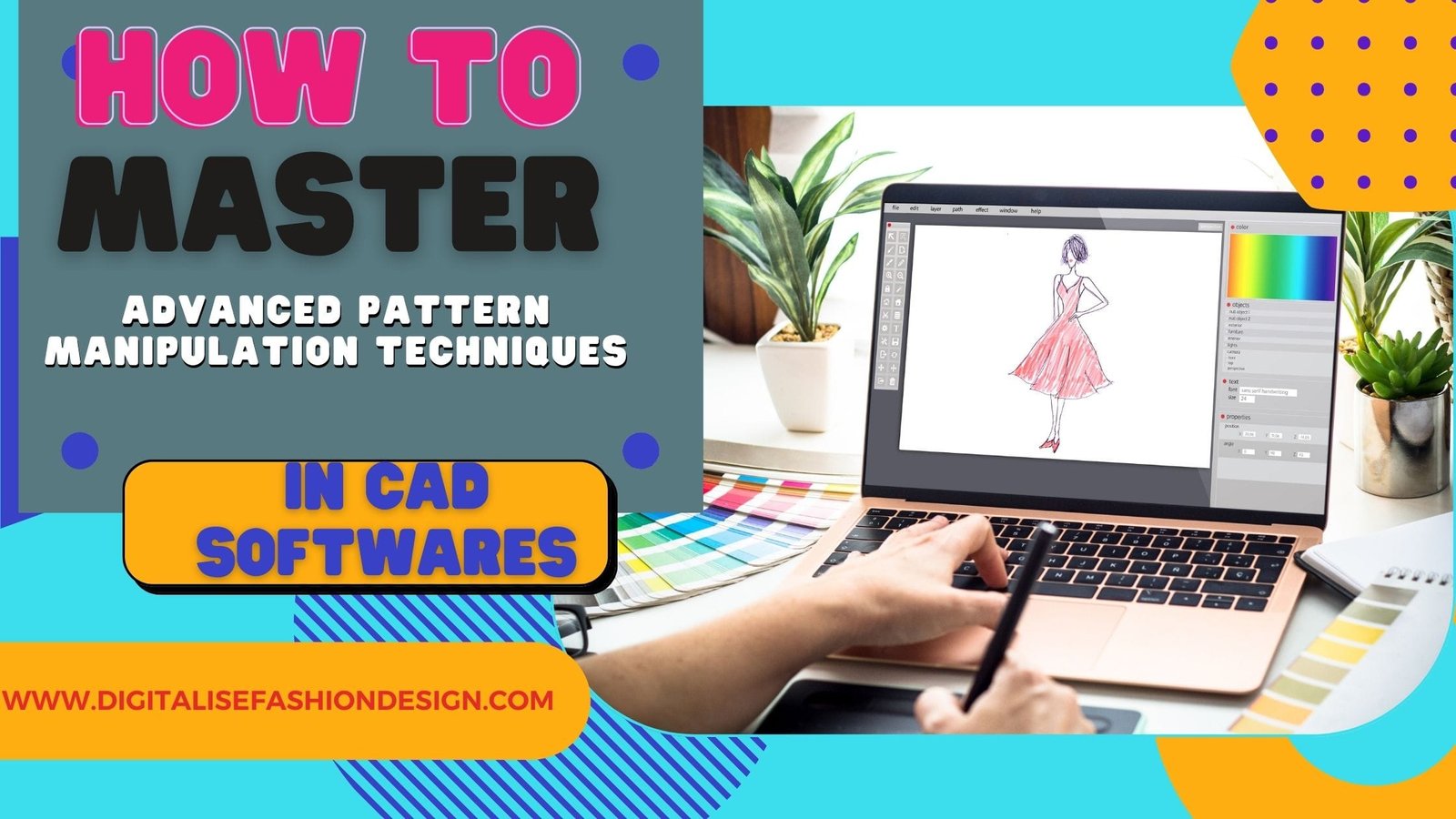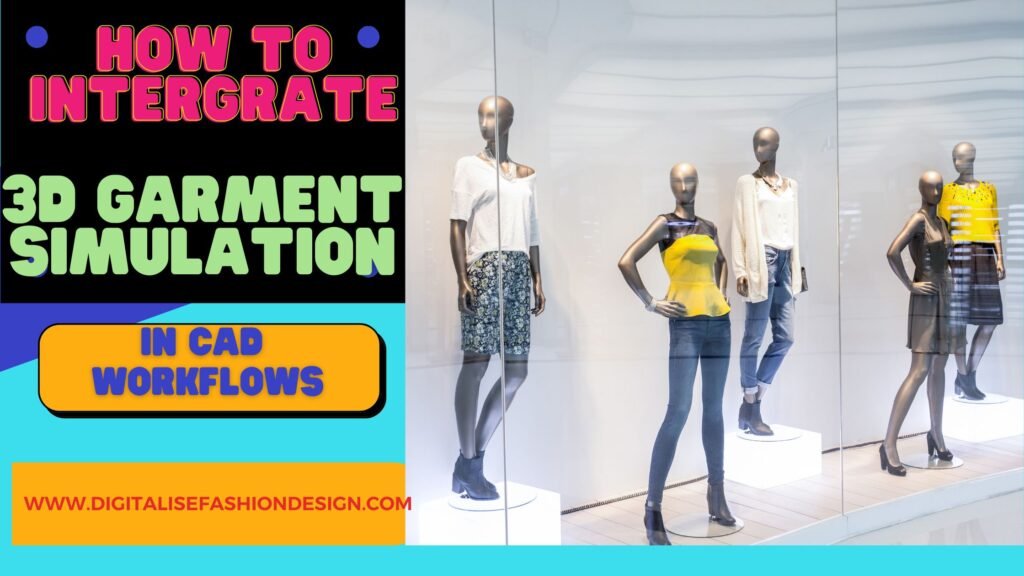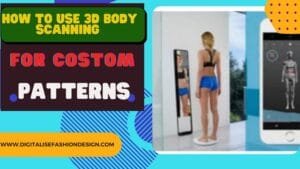Introduction to Advanced Pattern Manipulation in CAD

In today’s fast-paced fashion industry, Computer-Aided Design (CAD) software has
become an indispensable tool.
Whether you’re a budding designer or a seasoned couturier, mastering advanced pattern manipulation within CAD software can significantly streamline your creative process.
From editing existing patterns to creating bespoke designs, CAD technology enables designers to explore new frontiers in garment construction and design with unprecedented precision.
Pattern manipulation, traditionally done by hand, has been transformed by digital tools.
With the right CAD techniques, designers can experiment with digital draping, 3D virtual prototyping, and couture-level customization, allowing for greater creative freedom and efficiency.
Understanding advanced pattern manipulation in CAD
What is Advanced Pattern Manipulation?
Pattern manipulation involves altering a base pattern to create different design variations.
This can include adding darts, changing seams, adjusting lengths, or creating entirely new garment features.
In CAD, this process becomes even more advanced, offering a level of precision that manual manipulation simply cannot match.
How CAD Software changed traditional Methods
The evolution from manual to digital pattern design is one of the most significant changes in the fashion industry.
CAD software brings automation, allowing designers to quickly visualize changes, make modifications, and test different designs in real time.
These digital tools help save time, reduce errors, and offer endless creative possibilities.
Key Features of CAD Software for advanced pattern manipulation
Fashion-specific CAD programs come equipped with a variety of features that simplify and enhance the design process.
Vector-Based Drawing Tools
Vector-based tools allow designers to create precise, scalable patterns. These tools make it easy to modify lines, curves, and shapes, ensuring accuracy in every part of the design.
Seam Allowance and Grainline Control
Most CAD software includes tools for adjusting seam allowances and controlling grainlines. This ensures that your patterns are production-ready, reducing the likelihood of errors during the manufacturing process.
Measurement and Fit Precision
Another powerful feature of CAD software is its ability to handle precise measurements, ensuring that patterns fit perfectly for different body sizes and shapes.
Advanced Pattern Manipulation Techniques in Pattern Editing.
Digital Slicing and Slashing
CAD software enables designers to use advanced pattern manipulation editing techniques like digital slicing and slashing. This allows you to split patterns into sections, creating more dynamic and versatile designs.
Merging and Blending Patterns
Merging multiple patterns together or blending elements from different designs can be done seamlessly in CAD. This level of customization is perfect for creating unique, couture-like garments.
Dart Manipulation
Dart manipulation is crucial in tailoring and garment design. In CAD, this process becomes faster and more accurate, allowing you to experiment with various dart placements and shapes.
Advanced pattern manipulations techniques: :Exploring Digital Draping
What is digital draping?
Digital draping simulates how fabric will behave on a three-dimensional form, allowing designers to visualize the garment in a more realistic way before any physical samples are made.
Benefits of Digital Draping Over Traditional Methods
Unlike traditional draping, which requires physical fabric and mannequins, digital draping is done entirely in the software.
This speeds up the design process, reduces waste, and allows for more immediate experimentation with different materials.
3D Virtual Prototyping in Pattern Design
How 3D Prototyping Enhances Design Accuracy
3D virtual prototyping in CAD enables designers to create and test garment designs in a simulated environment. This helps ensure that the design will function as intended before physical production begins.
Real-Time Simulation of Fabric Behavior
One of the most innovative aspects of 3D virtual prototyping is the real-time simulation of fabric behavior. Designers can experiment with different textures, weights, and weaves to see how they interact with the body and movement.
Achieving Couture-Level Precision with 3D Tools
For high-end designs, the precision offered by 3D tools is invaluable. You can manipulate patterns at an incredibly detailed level, ensuring that each stitch, seam, and dart is perfectly placed.
Integrating Custom Fit Adjustments
How CAD Allows for Body Measurement Integration
CAD software allows for easy integration of custom body measurements, ensuring that patterns can be tailored to fit individual clients perfectly.
Tailoring Patterns to Individual Body Shapes
This customization feature is especially useful for designers creating bespoke garments or working with clients who have unique body shapes. With CAD, you can create patterns that are truly one of a-kind.
Leveraging Layers and Textures for Design Depth
OTHER INTEREST BLOG POST
Adding Textures and Fabrics in CAD
Incorporating textures and fabrics into your digital patterns adds depth and realism. CAD software allows you to simulate different materials, helping you visualize how your design will look and feel.
Enhancing Design Realism Through Layered Patterns
Layering patterns with different textures and fabrics can create a more dynamic and visually appealing design. This is particularly useful in outerwear, couture, and avant-garde fashion.
Advanced Pattern Manipulation: Grading Techniques in CAD
Automating Size Ranges
CAD software simplifies the grading process, allowing you to automatically adjust patterns for different sizes. This is a huge time-saver for designers working on collections that span multiple sizes.
Multi-Size Pattern Grading
Grading patterns for multiple sizes can be a complex process, but CAD software makes it straightforward. With just a few clicks, you can create size variations without compromising the integrity of the design.
Exporting and Sharing Digital Patterns
Export Formats for Production and Collaboration
Once your design is complete, you can export your patterns in various formats, such as PDF or DXF, making it easy to share with manufacturers and collaborators.
CAD to PDF or DXF Files
The ability to export to standard file formats ensures that your digital patterns can be used across different platforms and software.
Sharing Patterns with Manufacturers
CAD software facilitates the sharing process, allowing for seamless communication between designers and manufacturers, ensuring the final product matches the original design.
Benefits of Mastering CAD for Couture-Level Design
Mastering CAD software enables designers to work more efficiently while also pushing creative boundaries. The precision and customization options available in CAD allow for couture-level designs that are both intricate and perfectly fitted.
Common Challenges in Advanced Pattern Manipulation in CAD
Potential Hurdles Designers Face
Learning advanced pattern manipulation in CAD can be challenging, particularly for those who are new to digital design. Issues like software complexity or limited training resources can pose initial difficulties.
Solutions and Best Practices
However, with practice and the right resources, these challenges can be overcome. Many designers find that online tutorials, workshops, and experimentation are key to mastering these techniques.
The Future of Pattern Design with CAD Technology
AI Integration in CAD
Artificial Intelligence (AI) is beginning to play a role in CAD software, automating some tasks and assisting
designers in generating even more complex patterns.
Virtual Fashion and the Metaverse
As fashion moves into the digital realm, with virtual garments and the metaverse, CAD technology will become even more critical. Designers will be able to create garments that exist solely in virtual spaces, pushing the boundaries of what fashion can be.
Conclusion
Incorporating advanced pattern manipulation techniques in CAD processes can elevate your designs, streamline production, and open up new possibilities for creativity.
Whether you’re creating digital prototypes or experimenting with couture-level details, mastering CAD is essential for any modern fashion designer.
FAQs
What CAD software is best for pattern manipulation?
Several CAD programs are popular for pattern manipulation, including Optitex, CLO 3D, and Gerber. Each offers unique features that cater to different aspects of the design process.
Can beginners learn advanced CAD techniques?
Yes, beginners can learn advanced techniques with practice and the right resources. Many software platforms offer tutorials and training programs to help designers build their skills.
What’s the difference between 2D and 3D pattern design?
2D pattern design focuses on flat patterns, while 3D pattern design allows for the creation of garments that are visualized in three dimensions, offering a more realistic view of how the final garment will look.
How can CAD improve sustainability in fashion?
By allowing designers to experiment digitally, CAD reduces the need for physical prototypes, which helps minimize waste in the production process. This contributes to more sustainable fashion practices.
Is CAD software necessary for a small design business?
While CAD software is a powerful tool, it is not strictly necessary for every small business. However, it can significantly improve efficiency, precision, and collaboration, making it a valuable investment for long-term growth.








